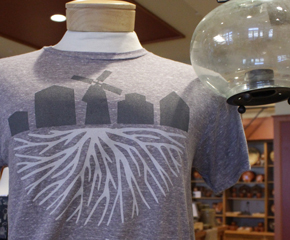
Turning Technology into Furniture
7 artifacts in this set
This expert set is brought to you by:
The staff at The Henry Ford
Florence Sewing Machine, 1860-1865
Sewing machine (Equipment)
When new inventions like stoves, sewing machines and radios first came on the market, they seemed jarring and out of place next to people's furniture. Manufacturers learned that these devices would sell better if their mechanisms were hidden behind stylish cabinetry or fancy decoration. Fashionable parlor furniture inspired the ornately scrolled and pierced iron legs of this elaborately decorated sewing machine.
Parlor Stove, 1886
Stove (Heating equipment)
This heating stove was intended to blend with furnishings made in the Victorian Aesthetic Movement. Aesthetic designers sought to transform Victorian taste away from popular revival styles toward something new and elegant. There was no single Aesthetic style, rather a common set of design motifs, including stylized botanical forms, and an interest in elegant decorative tiles, which appear on this stove.
RCA-Victor Console Television Receiver, 1948
Television receiver
This television was at the top of R.C.A.'s 1949 line. It sports a 16 inch screen described as "America's Sweet 16" in the company's advertising, when the standard screen was only 10 inches. Most importantly, the case could blend into the owner's Queen Anne style decor, with its hand rubbed walnut or mahogany finish. This model was also offered in Federal and Modern style cabinets.
Predicta Television Receiver, 1958-1960
Television receiver
Mid-twentieth century home entertainment technology -- radios, stereos, televisions -- tended to be hidden by furniture casework. They were furniture pieces. Not so with this Philco Predicta from 1958; it reveled in its technology. The tube sits exposed and perched on its stand -- bound by no casework.
Edison Diamond Disc Phonograph, 1919
Phonograph
In the years just after World War I, Americans loved listening to music on their phonographs. Thomas Edison's Diamond Disc Phonograph Company was at its peak of production. Styled to harmonize with parlor or library furnishings, the case was designed in the popular Colonial Revival style, hiding the workings of the phonograph behind fine wood and inlays.
Kenmore Electric Rotary Sewing Machine, 1950-1955
Sewing machine (Equipment)
This 1950s sewing machine has a minimal, modular look that shows a lightness of touch in its simple intersecting shapes. It is blatantly modern and is admirable for its lack of style -- which becomes style in itself. Well-articulated and neatly interlocked, it utterly escapes the trappings of earlier sewing machine designs.
RCA Radiola 60 Radio in Custom Made Cabinet, 1927-1928
Radio
The RCA Radiola 60 receiver is carefully concealed in a custom-made case by Anthony Osebold, a European-trained carver of church altars in Detroit. This example is an opulent showcase of his woodworking skills. The cabinet's appeal is two-fold: it houses some of the most refined radio technology available at the time--yet its lavish craftsmanship harkens back to earlier historical traditions.


